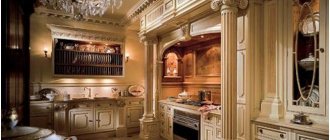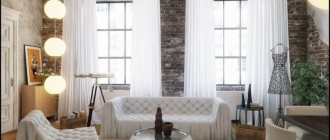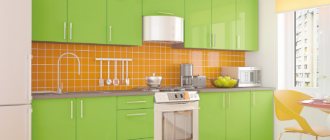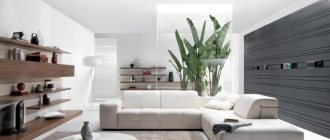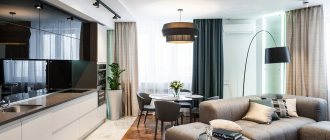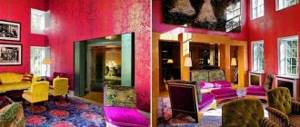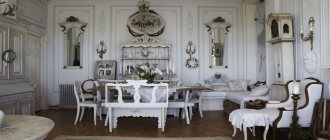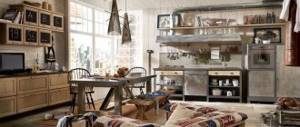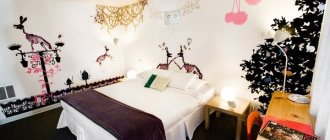Features of the constructivism style
The constructivist style originated in the thirties of the twentieth century. The basis of constructivism is rationalism and practicality. This idea arose in contrast to the foundations of Tsarist Russia. Post-revolutionary society wanted to isolate itself completely from the bourgeois past and, in defiance of the “philistine” interior design, create a completely new one - functional and simple.
Proletarian constructivism appeared as a Russian echo of the avant-garde style that was gaining popularity in Europe in those years. This direction in the design of premises puts the design, rather than the composition, to the fore. The style arose as an experiment, which makes it possible to create something unusual, new, without pretentiousness or embellishment.
Laconic shapes, light shades, large space - all this corresponds to the chosen design
Many adherents of this style think clearly and express their opinions in a similar way: “A bed is only needed for relaxation, why decorate it with gold elements or stucco?” They consider all decor that has no practical use to be unnecessary.
The main features of constructivism in the interior:
- laconicism of forms;
- lack of ornateness;
- clear color separation;
- strict geometry of forms;
- use of practical materials;
- rationalism;
- simplicity.
Other similar design trends - minimalism, high-tech - also take their origins from constructivism.
Particular attention should be paid to Soviet constructivism, which appeared as a government order. The red thread of this idea was the socialist community. Working common people took over the premises of the former bourgeoisie and made their own “amendments” to the interior in the form of simplification, getting rid of luxury, and eliminating any hint of decor.
Factory-made, mass-produced furniture, uniform arrangement of rooms, standard design of the interior of housing, lack of individual items, getting rid of “philistine” things (figurines, napkins, etc.) - all this became the slogan for Soviet people for many years.
The room looked ascetic and uninteresting in the era of Soviet constructivism
Modern constructivism has surpassed the Soviet understanding of this style as something simplified and faceless. With the help of constructivism, you can express your individuality depending on your ideas and material capabilities.
We decorate an apartment in constructivism style
If you decide to create an interior design for a room in the constructivist style, then you should take care to comply with the basic standards:
- Expediency. Practical necessity is what underlies every object and structural design element. If there are chairs, then exactly as many people live in this room; if the sofa is of the size that fits into a certain niche. The choice of carpet is determined by its ability to warm the floor, not by its beauty; a table lamp is needed only for reading, etc.
- Spaciousness and breadth of areas used. Excess partitions are removed, and movable lightweight modules are used as zoning elements.
- Use of wall space. Niches in the walls carry a multifunctional load - cabinets, alcoves, built-in places for relaxation or storage.
- Lack of decorative elements. All “participants” in filling the interior should be restrained and simple, without ornateness or even a hint of decoration.
- Application of the most modern technologies and innovative materials. Glass, concrete, and metal design are in favor. Constructivism “does not oppose” such natural components as flax, wood, jute, hemp, bamboo, etc. Composite materials are not forbidden - porcelain stoneware, artificial stone.
- All interior elements must have clear lines and regular geometric shapes. The most commonly used items are rectangular, but rounded parts are also acceptable.
- Backlighting is used to complement the main light. The lighting design somewhat softens the correctness and clarity of this style.
- The tone in choosing colors should be in favor of black, white and gray shades. They are the ones who emphasize commitment to style.
- Decorative elements appeared in the modern “reading” of constructivism. Nowadays, the use of paintings and glass elements is allowed, but their forms must be correct and verified.
By adhering to all of the above points, you will be able to recreate the atmosphere of true constructivism in your home.
Constructivism color scheme
As noted above, choosing the right color scheme is critically important for this style, because it is through color that the decorative effect in the rooms is achieved. With the help of bright, rich, often contrasting colors and shades, you can make the interior original, pleasing to the eye, and most importantly, not boring.
Read more: Vintage style
In fact, you can use any colors and shades to create a constructive design, but the following colors are considered the main ones for this style: black, yellow, blue, white, red, metallic. It is these colors that you need to focus on so that none of your guests have any doubts that the room is made in the style of constructivism.
An important component of such decor will be color. It is preferable to make surfaces monochromatic. At the same time, there are no special restrictions on the choice of specific paints. Unless it’s better to leave too bright colors for another renovation. Since the style is similar to the high-tech direction, all metallic colors will look great here.
It is important to use no more than three colors in combinations - otherwise the picture will turn out to be too colorful. If sufficiently dark finishing tones are chosen, they can be “diluted” with small bright accents of decor or paintings. However, a better idea would be to use two dark and one bright shade in the design.
The color palette of the constructivism style is based on the fact that there are three main colors for the background - black, milky and gray, which can be complemented with beige or any shade of brown.
However, bright spots of red, blue, or yellow can be added to this color scheme.
Modern constructivism, in contrast to the earlier original style, is softer. In modern interiors of the constructivist style, paintings are used as decorative elements, as well as objects made of glass or stone with a clear, laconic form.
It became acceptable to use combinations of different materials and the presence of partitions.
Color solutions
Monotony is a characteristic feature of constructivism. The choice of light gray, black and white, light green will correspond to the chosen style. Minor accents in the form of bright red, dark gray, yellow are acceptable.
Small bright spots are acceptable in the constructivist style
The use of shades of color with a metallic effect looks very stylish.
No more than three shades should be repeated in all decorative elements, with the possible addition of bright colors.
This color scheme suits the chosen style
Constructivism: nothing superfluous
In the spirit of the constructivist style, there is no decor in the interior. As was already written above, the task of this style was to show the progress of that time, to focus a person’s attention on the functionality of objects, even if this sometimes went against convenience. It was believed that a person could get used to any environment.
Interior in constructivism style photo
Constructivism style in the interior
Decoration of floors, walls, ceilings
No stucco molding or pretentious elements are acceptable in the design of walls, floors and ceilings. Everything is restrained and laconic.
Ceiling
To create a ceiling in the constructivist style, you can use stretch ceilings with a glossy surface. All coverings for the ceiling of the room must be even and smooth.
The use of a glossy ceiling in a constructivist room is stylish and appropriate
The ceiling can literally reflect the pattern of the walls. Strips of wall covering can flow organically onto the ceiling.
In rooms with high ceilings, it is appropriate to create geometric regular structures. To do this, you can use drywall painted white.
This design of the ceiling emphasizes commitment to style
Walls
An even, smooth coating on the walls is just as welcome as on the ceiling. The main color is white, but other shades are also possible - red, yellow, blue.
White color is the most applicable color in constructivism
If you want to “revive” the walls with some kind of pattern, then use the simplest shapes - rectangles, wide stripes, circles.
Paint or wallpaper are used as wall materials. The main thing is not to use a floral or patterned print (with the exception of simple geometry).
The number of walls is minimized, they are simply demolished, and to highlight certain zones, partitions are used that can be easily transported from place to place. You can even hang a photo or two on these portable elements or nail a small shelf for a houseplant.
Floor
Laminate, linoleum, carpeting are the most suitable materials for finishing floors in the constructivist style.
Linoleum laid in the kitchen is perfect for this room
Regular floor mats do not fit into the style of this design. As an option, you can lay parquet in light colors.
The color of the floor is usually close to two shades - white and black.
The dark color of the floor contrasts with the white ceiling and walls
Ceramic tiles are used in the kitchen. As a rule, this material is taken in a light version.
The emergence and development of constructivism
Constructivism appeared in 1913, when the Russian sculptor Vladimir Tatlin traveled to Paris. In the French capital, the masters were indelibly impressed by the works of artists Pablo Picasso (Spanish: Pablo Picasso) and Georges Braque (French: Georges Braque). After returning to Russia, the inspired Tatlin began to create similar works, and it can be considered that a new direction appeared at that very moment.
Constructivism in the first years of its existence was represented by paintings with a large share of abstractions. From this point of view, he was close to Suprematism, created around the same time by the brilliant Kazimir Malevich. The artist believed that the true essence of painting should be complete non-objectivity, and the first constructivists reasoned in much the same way. Over time, the new style, however, developed its own accents that set it apart from Suprematism and other trends. A great contribution to the movement in this direction was made by Antoine Pevsner (French Antoine Pevsner) and Naum Gabo (French Naum Gabo).
A group of avant-garde artists held the first exhibitions of paintings written by constructivists in Moscow, St. Petersburg and Odessa. In 1920, Antoine Pevzner and Naum Gabo released the Realist Manifesto, in which they sharply opposed futurism and cubism. The authors criticized the use of volumes and lines as purely external elements and proclaimed that it was such details that created the “idea of depth”, connecting space and time.
Piet Mondrian and Theo van Doesburg founded the art society De Stijl and added new techniques to the movement. The first painter used a grid of vertical and horizontal lines to create his works, the second introduced dynamics into the paintings by using diagonals.
Painters, graphic artists and photographers often worked in the constructivist style to create posters that informed the public about certain events. In most cases, these works were combinations of geometric shapes depicted on a blank canvas. Looking at them, you clearly see the difference with paintings made in many other styles - for example, such as realism.
A new impetus to creativity in the 30s of the last century was given by the French artist František Kupka (Czech: František Kupka). He became one of the founders of the “Abstraction-Creation” society, in which he advocated the active use of geometric elements in constructivism. Kupka and other artists of the society experimented with light and color, developing “volumetric plastic vision” and the “flicker effect.” “Abstraction-Creativity” actively promoted constructivism, which is why public interest in it increased significantly.
Modern constructivists are similar to the pioneers who worked in the early years of the style’s existence, but they also differ from them in many ways. They also strive to simplify, but their works are adapted to the man of our time and his needs.
Selection of furniture and equipment
Furniture for its intended purpose is the main postulate when filling an interior in the constructivist style. The aesthetic side of furniture fades into the background, giving way to practicality and functionality. Chairs are for sitting, a table is for working or eating, a sofa is for relaxing, a closet is for storing clothes or dishes.
Functional and apparently simple furniture is a sign of the chosen design
Any decorative elements are unacceptable. The legs of furniture pieces are small, without pretentiousness, furniture shapes are preferably the simplest - circle, square, rectangle. When choosing furniture, you should not strive for uniqueness; this is completely irrelevant in constructivism. The amount of furniture in the room is minimal.
Only the essentials should be placed in a room of this design.
Even furniture coverings should serve a clearly defined purpose. For example, a sofa blanket is not used for decoration, but to warm the owners of the room.
The materials that designers use for furniture are wood, metal, leather, fabric, leatherette. Open designs of shelving, shelves, and cabinets are another noticeable aspect of furniture.
The latest technology fits perfectly into the constructivist style. It seems to be in tune with this design direction, so any room equipped with the latest household appliances will correspond to this style. The interior contains huge plasma TVs, home theaters, built-in washing machines and dishwashers, etc.
All equipment that meets modern requirements is built-in and practical
By loading the room with the achievements of technical progress, you can not only surprise your guests, but also be on the same wavelength with the chosen design.
Lighting
Naturalness is one of the requirements of constructivism for lighting. The windows are large and not covered with curtains - quite in the spirit of this design. If there is a need for privacy from prying eyes, then blinds or roller blinds in white are more often used. Panoramic windows, glazed doors with access to a balcony or terrace are an excellent solution in constructivism.
You can get a lot of natural light using floor-to-ceiling windows
Artificial lighting is also acceptable; light sources in the room are placed specifically in those places where it is necessary from a functional point of view. Spotlights are especially loved by designers working in the constructivist style.
In the constructivist style, lighting should be where it is needed
Lights can be placed only where they are needed: in the working kitchen area, in a place where you read books and magazines, near a chair with your favorite handicraft, etc.
This lighting option does not go beyond the constructivist style.
All lighting fixtures must have laconic forms, without additional decorative elements. Geometric shapes are most preferred.
Living room
Typically, the living room is decorated in the constructivist style by people who like simplicity and practicality. The advantage of creating an interior in this style is that rooms of any layout and any size are suitable for this style.
When planning to organize the interior of your living room in the constructivist style, first of all you need to decide on zoning, how many zones are needed and for what functions. If the functionality of the room requires a partition, then you should not refuse it, the main thing is that it is useful.
Placement of accents
The main thing to consider when creating constructivism in the interior is to create an emphasis on freeing up space. The more free space, light, the less unnecessary things and furniture - the better.
It is advisable to expand the space by eliminating partitions; in such a room there are practically no rooms - only zones for a specific purpose.
The visual expansion of space is helped by the use of monochrome light colors in the design of walls, ceilings, floors and furniture.
Despite all the apparent simplicity of constructivism, you should not approach interior design lightly. Before starting the process, you need to think carefully and plan everything.
Interior design in constructivism style
The main trends of constructivism must be observed in any interior, but the design of each room may be slightly different.
Living room
This simple and concise style is suitable for people who know exactly what they are striving for. As a rule, purposeful and organized owners prefer a living room in a constructivist design.
Nothing superfluous and no decor - these are the principles of designing a constructivist room
This style is suitable for a living room of any size. Light colors used on the walls and ceiling will help visually expand a small room. To expand space and highlight, you can use acrylic partitions, glass panels, and vertical structures.
In a constructivist living room, it is better to make shelves and cabinets built-in. All furniture in color matches the curtains (or blinds) and walls. The living room has a soft sofa, a couple of armchairs, and a coffee table made of glass or wood. All these items are of regular geometric shape; decorative elements are not welcome.
To add warmth to the floor, you can add a light-colored, high-pile carpet, and for lighting, use spotlights around the perimeter of the room.
The choice of material for a living room in the constructivist style depends on the financial status of the owner of the room. The selected design can be preserved when using natural or artificial stone or wood parquet boards. The panel design of the walls also corresponds to constructivism. The main thing is to try to maintain a single style concept.
To create coziness, you can place a small pot of flowers on the windowsill, and put several functional pillows on the sofa. Soft pillows can be placed under your back or you can sit on them. Modern design masters “allow” the use of suitable posters or posters in the constructivist living room (for example, in the form of photo wallpaper).
Bedroom
Built-in furniture, light walls, a sofa that replaces a bed, a small closet - that’s all that can be in a constructivist style bedroom.
Restrained colors, geometric designs, minimal decor - everything meets the requirements of constructivism
In the bedroom you can experiment a little and use prints or collages. They should be placed on the wall or ceiling, but do not try to “squeeze” flowers and other “liberties” into the constructivist style. Only correct shapes and geometric patterns are acceptable in the design of a room.
Metal and glass structures will not interfere with the bedroom interior, but not as decor, but as basic elements.
Kitchen
For a kitchen in the constructivist style, functionalism is especially important. All items in this room should be practical and comfortable.
Practicality and conciseness are the main characteristics of such a room
The design of the kitchen space should not be limited to traditional materials. The tabletop made of tempered glass looks very original and stylish. Ceramic tiles can be used on the floor and walls, but in very large formats and smooth texture.
Smooth panels, facades without roughness or decoration, and a restrained color palette are the basic requirements for kitchen furniture in the constructivist style. Greater functionality of the kitchen set can be achieved through the use of built-in baskets, internal door surfaces, and pull-out storage modules.
Furniture for eating - a dining table, chairs or sofas - can be in the form of a transformer: folding, retractable. This is very convenient and saves free space.
If the kitchen space is rather large, then it is worth purchasing solid and durable furniture - made of oak, for example. The shapes of such objects are only simple and uncomplicated geometric shapes, without decorative elements.
An abundance of the most modern household appliances (glass, metal) is quite appropriate in a constructivist kitchen.
Photo gallery: interior design options in the constructivist style
You can get ideas for decorating various rooms in the constructivist style by watching the video.
Video: interior in constructivist style
People who do not have a special love for pretentiousness and decoration will be able to please themselves by decorating premises in the constructivist style. This design solution will suit purposeful and practical people, because each piece of furniture will have its own specific function and will not be burdened with decor.
- Author: Elena Aleshina
Rate this article:
- 5
- 4
- 3
- 2
- 1
(0 votes, average: 0 out of 5)
Share with your friends!
Style features
The main features of constructivism were manifested in the new aesthetics of things.
The main theoretical principles of this direction are set out in the works of the Viennese architect and publicist Adolf Loos, namely:
- Refusal of elaborate decorations and artistic excesses. It became the main idea of the direction. This concerned both architecture and artistic and industrial practice.
- Refusal of ornaments and other decorative elements. This is especially evident in architecture. Houses in the Constructivist style were presented as a “single form” that did not require any decoration or decoration, unlike the Empire style.
- Intricate shapes of objects are losing relevance. They are being replaced by more rational images.
- The main criterion for the aesthetic value of a thing is its expediency and possibilities of practical application. The desire for maximum rationality of forms was supported by the possibilities of machine production and implied a complete rejection of manual artistic finishing.
- Development of the art industry.
- The main attention was paid not to the beauty of the object, but to its functional purpose. It was believed that the forms and decorations of things inherent in handicrafts were not appropriate in the age of machine production.
Architecture
The constructivist direction was widely used in Soviet architecture of the 20-30s of the last century.
The rapid development of industry, transport and urban growth did not correspond to the classical urban layout with narrow streets and elaborate buildings. In this regard, constructivism, aimed at maximum efficiency and rationalism of the new time, made it possible to solve the problem of not only transport services, but also optimal settlement and maintaining sanitary living conditions.
The residential complexes created during this period were focused on the needs of the middle and low-paid categories of citizens and consisted of economical standard apartments.
Soviet constructivism involved the development of not just a specific building or structure; universal blocks, streets and principles of their combination were developed. The latter also included urban transport routes.
Constructivism in architecture often manifested itself in the use of fairly simple formal elements, completely devoid of any decor or decoration. All parts of the building were connected in accordance with the plan for organizing the internal space, and their shape was determined directly by the purpose of the premises.
Even during the dominance of constructivism and other modernist movements in Soviet architecture, architects worked based on the architectural traditions of antiquity and the Renaissance.
It was also believed that the architect was obliged to think through not only the general concept of the building, but also the placement of signs, clocks, elevator shafts and loudspeakers, which were also considered part of the architectural image.
The Soviet constructivists, who became the progenitors of the style, focused their efforts on solving two problems - designing an exemplary socialist city and creating apartment communities for workers.
Moreover, the responsibility of architects began to include not only residential buildings, but also department stores, workers' clubs, printing houses, sanatoriums, plants, factories, power plants, etc.
In the history of Russian constructivism, the city of Yekaterinburg is of particular importance. During the period of rapid construction of the first Soviet five-year plans, constructivism was recognized as the official architectural style of the country. By a happy coincidence, during this period a whole group of talented architects practiced in Yekaterinburg. The latter, thanks to the total development of the city, had the opportunity to bring to life even the most unpredictable ideas. So Yekaterinburg acquired 140 unique buildings. No other city in the world can boast such a concentration of architectural monuments.
Constructivism, as one of the styles of avant-garde movements, became widespread not only within the USSR, but also in a number of other states.
A striking example of constructive architecture was the Eiffel Tower erected at the Paris World Exhibition.
Eiffel Tower, Paris
Interior features
The interior of houses in the Constructivist and Art Deco styles fully corresponded to the main features of the direction and included the following features:
- clearly defined frame and compact shapes;
- the absence of any mysteries and secrets - each item performed exclusively the functions assigned to it.
Constructivism involved the creation of spacious overall rooms; the use of walls and partitions was kept to a minimum. Sometimes movable screens were used to divide rooms. The decor lacked any frills - ornaments, moldings. The main colors were: white, black, grey, metallic, red and yellow. Although constructivism rejected decor, however, it was possible to create small accents through the use of bright coatings or lighting. The walls and ceiling were often finished with plain plaster or paint. Parquet boards were used as flooring. As for furniture, the main requirements for it were convenience and functionality. Such furniture often had a pronounced frame and regular geometric shapes.
Sculpture
As part of the development of the constructivist direction, sculpture also received considerable development. In the early 20s, Soviet constructivists formed the Institute of Artistic Culture (INHUK), uniting sculptors, architects, artists and art historians. Constructivist sculpture was based on the concept of constructing forms, based on the expression of internal structural connections between the geometric elements of the composition and the combination of various textured materials.
At this stage the sculpture was abstract in nature. So, instead of depicting familiar human characters, the masters used intricate geometric designs. The purpose of demonstrating the latter was to amaze the audience, to form a transition from image to design.
The activities of N. Gabo and N. Pevzner played a special role in the development of constructivist sculpture.
Gabo is known for his experiments in spatial plasticity (heads of planes), while Pevzner became famous for the creation of non-objective cubic compositions. The purpose of these works was to identify the shape and texture of objects. Later, Gabo formed a “Realistic Manifesto”, which reflected the concept of formation formed in those years, and contained the following provisions:
- reality is the highest beauty;
- denial of color, depth of composition was achieved through textures and tone;
- denial of the descriptive nature of the lines, they were perceived as the direction of forces hidden in the composition;
- denial of volume, depth was recognized as a measure of space;
- denial of mass in sculpture. It was believed that volume could be constructed from planes.
- denial of static composition.
